Bangalore to Madikeri by Road
T
he road distance from Bangalore to Madikeri is about 250km (155 miles). The driving conditions are mixed, but by and large it is a smooth ride. The road conditions and pretty good baring a few stretches.Two well maintained state highways - SH17 and SH88 - connect Bangalore with Madikeri via Mysore. From Bangalore to Mysore ( about 140 km ) you would be using the SH 17 and from Myosre onwards to Madikeri it is the SH 88.
Bangalore to Mysore by SH17 (Distance 147km, Driving time 3 hours):Bangalore ( NICE Expressway entry)– 25km –> Kengeri ( NICE Expressway exit ) — 82km —> Mandya — 40km –> Mysore city.
Mysore to Madikeri by SH88(Distance 100km, Driving time about 3 hours): Mysore –> Yelwal –> Hunsur –> Kempalapura –> Piriyapatna –> Bylakuppe –> Kushalnagara –> Suntikoppa –> Madikeri
You can bypass Mysore city, saves some time and distance...
There are two ways to bypass Mysore city. The first option is by taking the bypass road after Srirangapatna (about 15km before Mysore city) and the second bypass option is to take the Mysore ring road (about 10km before Mysore city).
If you take the bypass route near Srirangapatna , you can easily save some 30-45 minutes of Mysore city traffic. At Srirangapatna you will cross two major bridges across Kaveri River.
You enter Srirangapatna island through the first bridge and exit through the second bridge. Soon after you’ve crossed the second bridge out of Srirangapatna, you encounter a large junction. Take the right turn and soon you’ll see a railway gate. You need to take the road that crosses the railway track. The road at this point make a tentative left turn.
Unlike the Bangalore-Mysore road ( SH 17 ) you have been on so far, this particular road is narrower and much less crowded. This road zigzags through some wide stretches of paddy and sugarcane fields. After about 20 kilometers , at a place called Yelwal ( or Eliavala ) this bypass route joins a main highway, the Mysore-Mangalore SH88.
Before that you would have crossed the Ranganathittu bird sanctuary and the Brindavan Gardens ( KRS Dam) on your right. Both of them are a bit off from your road. A short detour towards right is needed to reach these two places.
As mentioned earlier, the second option to skip Mysore city is the take the Outer Ring Road, that encircles Mysore city. The Ring Road crosses SH 17 ( Bangalore-Mysore Road) at a major junction some 10km ahead of Mysore city. Take the right branch at this junction. About 15-20 minutes drive later , the ring road crosses the Hunsur road ( SH 88). You need to take the right turn into the Hunsur road.
Though ring road is less crowded than the road that crosses right through Mysore city, it is a bit longer. So if it is not the peak hours, you can easily drive through the city. The Bangalore-Mysore road eventually takes you to the Mysore Bus stand or railway station area . A little after the railway station turn right into the Hunsur Road (SH88). This road takes you out of the city towards Madikeri direction.
The second lap of the route to Madikeri is like this : Mysore - Yelwal - Hunsur - Kempalapura - Piriyapatna - Bylakuppe - Kushalnagara - Suntikoppa - Madikeri . This stretch’s distance is approximately 115km ( 72 miles ).
Baring the final 20 or 30 km stretch just before Madikeri , the SH88 is in excellent condition. For some considerable distances, it is 4 lane otherwise it is 2 lane. Also unlike the Bangalore - Mysore stretch ( SH17) of the route, the Mysore - Madikeri stretch doesn’t have a lot of fanfare in terms of fancy eateries and stuffs like that. However there are some reasonable restaurants at Hunsur town and also in Kushalnagara. You'll find a couple of Cafe Coffee Day outlets near Kushalnagara.
As you reach Hunsur, the highway splits into a Y junction. Take the right fork , and you will be skipping an otherwise crowded Hunsur town. Just as you take this right fork, on your left is a drive-in restaurant (Coorg Cafe) that serves good vegetarian food. Also there is a good coffee shop.
After you come out of Hunsur , SH 88 makes a tentative right turn. The straight road ( SH 88A) leads to Gonikoppal and Virajpet. Though this road also goes to Madikeri, stay on with SH 88 as it is shorter and better maintained. After Hunsur, if you are still right on the SH88 without and deviations you should cross Piriyapatna in about 15 minutes ( 20 km) from Hunsur.
After Piriyapatna a huge arch across the road announces the Tibetan settlement ahead in Bylakkuppe. This is one of the largest and oldest settlements of Tibetan settlements in India. As an indication you can see colorful prayer flags flying in the area. The Golden Temple , Namdroling Nyingmapa Monastery and the Sera Monastic University, one of the largest Buddhist universities in the world , is located in Bylakkuppe. It’s a few kilometers detour towards left from the main highway. For Bylakkuppe take the left diversion from a village square called Kuppam.
Nisargadama, an island formed by river Cauvery is located on the left as you come out of Kushalnagar town. This too is a popular tourist destination in Coorg.
Further ahead the highway passes through a forest. From this point onwards traffic slows down thanks to the narrow and often pothole ridden road condition. Also the road makes numerous bends frequently in this hilly area. This condition prevails all the way up to Madikeri town. In fact this is the slowest lap of the route from Bangalore to Madikeri. This last 20-30 kilometers can take anything up to and hour to cover.
As you enter Madikeri town you can spot many signboards by the state tourism department showing directions to various attractions in Coorg.
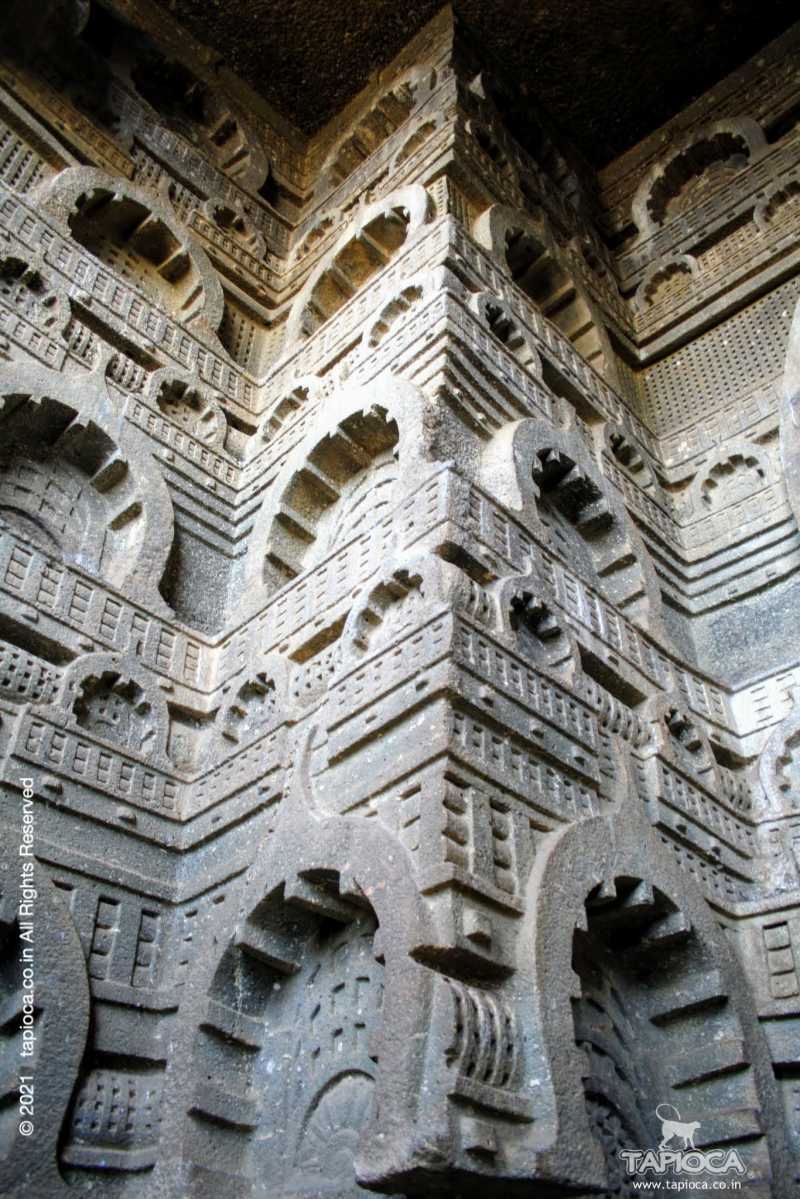 The fluted façade of the Chaitya.[/caption]
The center piece of Bedsa’a attraction is the majestically executed Chaitya (Buddhist Shrine) , especially its porch and the façade. The hall is all tall as a typical two storied building. Baring its impressive size, the other decorations inside the Chaitya hall would not compete with the beauty of similar such Chaitya halls elsewhere, say Karla or Ellora.
But the story of the façade and the porch are different. Probably it is for the first time in such Buddhist architecture the concept of a horizontally split façade is used in the main entrance. Instead of a giant horse-shoe shaped main door, the faced has a door at the height of a single floor and a horse shoe shaped window over this door.
On either side of this entrance and window are multiple bands of horseshoe windows. They are not exactly windows, but the imitation of it in a thrilling order, one over the other. A fluted projection on either side adds to the elegance of the façade.
In front of the façade, supporting the roof of the porch stands four gigantic pillars. The most beautiful part of these pillars is the capitals. If you can climb on the rocky hill, you can reach somewhat at the eye level of theses capitals.
A word of caution as you climb over the rock. The surface could be slippery, especially during the rainy season. There are practically no barricades of balustrades to prevent a fall from the cliff edge. Be careful and never venture close to the unprotected edges of the rock. It is as if you are standing on the balcony on the second floor without a protective railing.
[caption id="attachment_2089" align="alignleft" width="683"]
The fluted façade of the Chaitya.[/caption]
The center piece of Bedsa’a attraction is the majestically executed Chaitya (Buddhist Shrine) , especially its porch and the façade. The hall is all tall as a typical two storied building. Baring its impressive size, the other decorations inside the Chaitya hall would not compete with the beauty of similar such Chaitya halls elsewhere, say Karla or Ellora.
But the story of the façade and the porch are different. Probably it is for the first time in such Buddhist architecture the concept of a horizontally split façade is used in the main entrance. Instead of a giant horse-shoe shaped main door, the faced has a door at the height of a single floor and a horse shoe shaped window over this door.
On either side of this entrance and window are multiple bands of horseshoe windows. They are not exactly windows, but the imitation of it in a thrilling order, one over the other. A fluted projection on either side adds to the elegance of the façade.
In front of the façade, supporting the roof of the porch stands four gigantic pillars. The most beautiful part of these pillars is the capitals. If you can climb on the rocky hill, you can reach somewhat at the eye level of theses capitals.
A word of caution as you climb over the rock. The surface could be slippery, especially during the rainy season. There are practically no barricades of balustrades to prevent a fall from the cliff edge. Be careful and never venture close to the unprotected edges of the rock. It is as if you are standing on the balcony on the second floor without a protective railing.
[caption id="attachment_2089" align="alignleft" width="683"]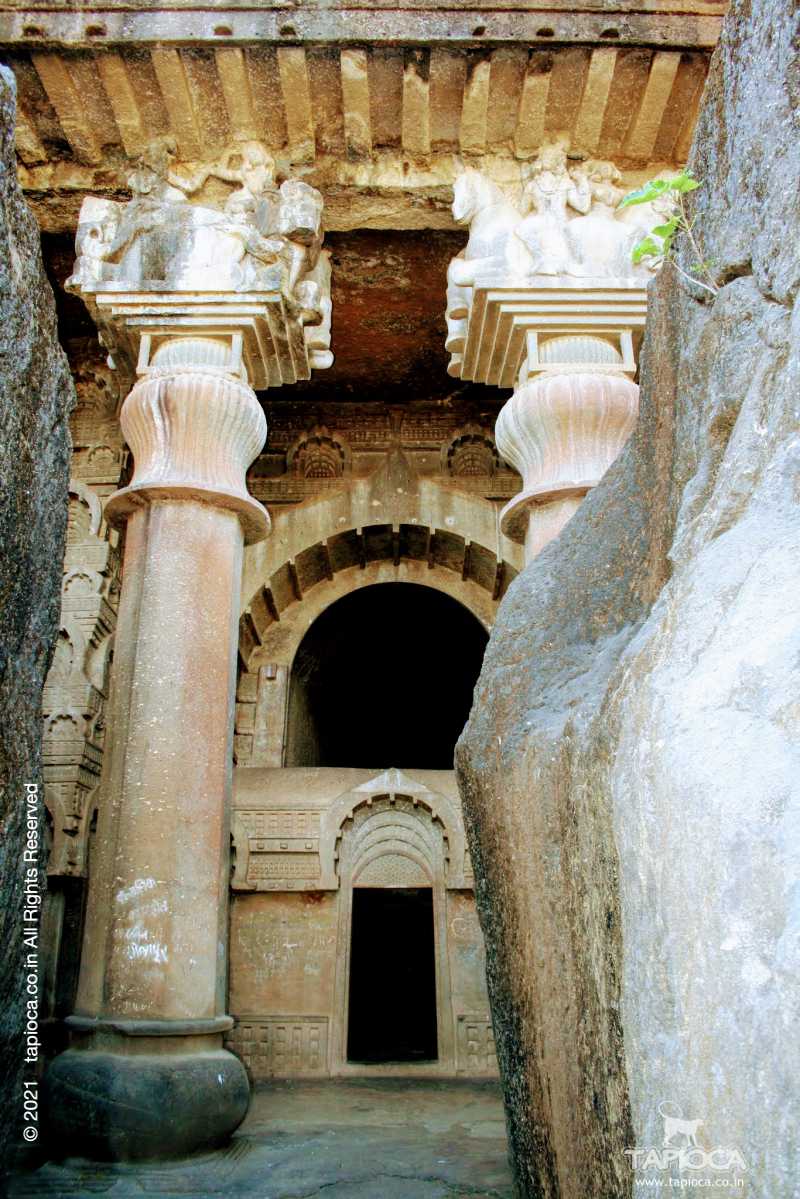 Pillar in the porch of the Chaitya with carved capitals[/caption]
Beautifully dressed couples are portrayed as sitting on horses and elephants. The horses and elephants are in kneeling posture with their feet projecting out of the capital. That gives an impressing as if those are stand alone sculptures rather than part of the pillar.
Now the capital itself sits on an inverted lotus flower shape feature. This lotus feature resembles exactly as the one in the capital of the Ashoka pillar.
Unlike many other such grand scale Chaityas, the façade of the Bedsa Chaitya is partially hidden by the un- removed rock in front. It is as if the camouflage the Chaitya, there is only a narrow passage cut on the rock to access the porch.
[caption id="attachment_1389" align="alignleft" width="1024"]
Pillar in the porch of the Chaitya with carved capitals[/caption]
Beautifully dressed couples are portrayed as sitting on horses and elephants. The horses and elephants are in kneeling posture with their feet projecting out of the capital. That gives an impressing as if those are stand alone sculptures rather than part of the pillar.
Now the capital itself sits on an inverted lotus flower shape feature. This lotus feature resembles exactly as the one in the capital of the Ashoka pillar.
Unlike many other such grand scale Chaityas, the façade of the Bedsa Chaitya is partially hidden by the un- removed rock in front. It is as if the camouflage the Chaitya, there is only a narrow passage cut on the rock to access the porch.
[caption id="attachment_1389" align="alignleft" width="1024"]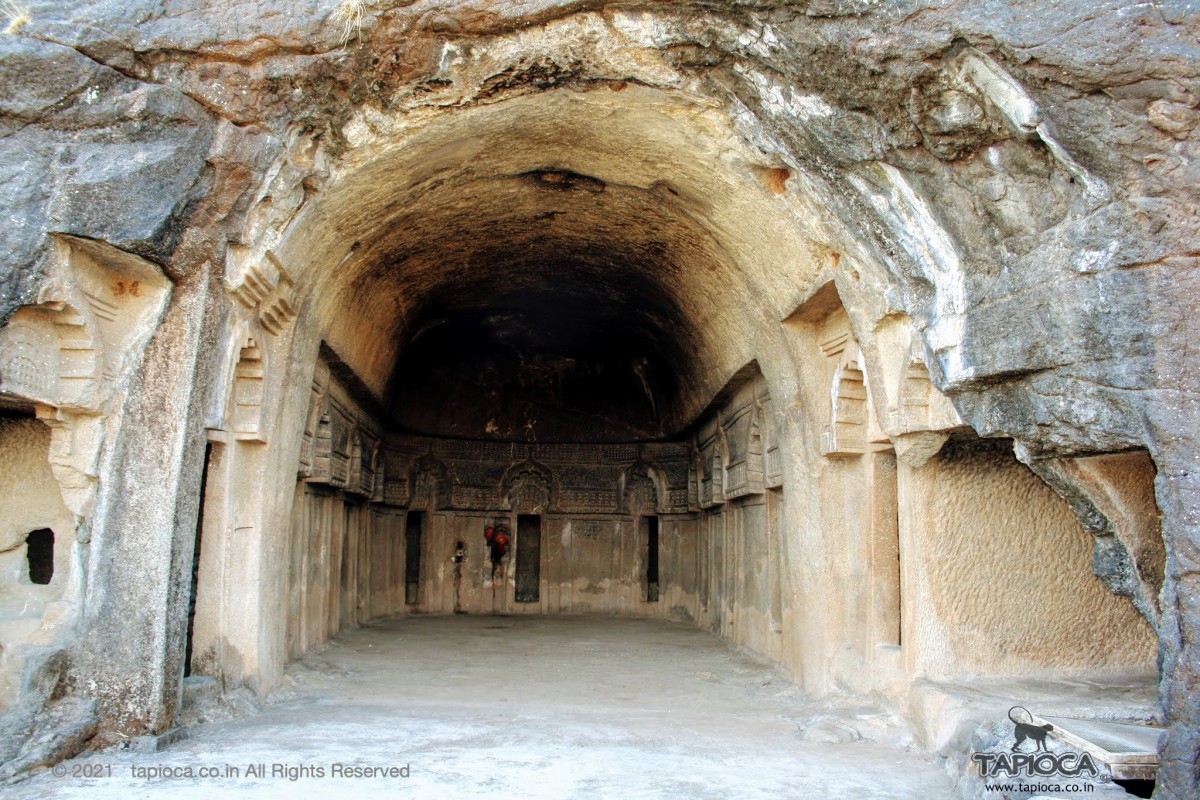 Fine example of the rock cut archetecture[/caption]
Inside of the Chaitya is typical. Rows of huge pillars stands on either sides of the Chaitya hall. At the centre of the semicircular end is the stupa with a protruding lotus bud image carved on the top.
The ceiling of the porch spots decorations that are smart imitation of such wooden structures.
[caption id="attachment_2090" align="alignleft" width="1024"]
Fine example of the rock cut archetecture[/caption]
Inside of the Chaitya is typical. Rows of huge pillars stands on either sides of the Chaitya hall. At the centre of the semicircular end is the stupa with a protruding lotus bud image carved on the top.
The ceiling of the porch spots decorations that are smart imitation of such wooden structures.
[caption id="attachment_2090" align="alignleft" width="1024"] The Chaitya Hall of Bedsa Cave[/caption]
On the left of the Chaitya a distance around the hill is a Vihar or a Montessori. There is a huge centre hall with many rooms scooped on to its inner wall. All the rooms with identical façade face the center of the call. You can even spot the beds carved on the rock inside the rooms. The ceiling of the Montessori spots the rows of socket holes where once the wooden frame ribs were fixed.
Another special feature you can notice on either sides of the main Chaitya are the water tanks dug on the rock surface. From the courtyard of the caves you can spot on either sides of the Chaitya , some rectangular recesses as tall as a typical door. On the floor just inside this recess are the water tanks. Meshed woodedn frames are installed to protect people from falling trapped.
It was probably to collect rainwater. You can even see on the rock surface groves cut to channel the rainwater to the tanks.
On the right of the Chaitya facing the courtyard is a stupa. Beyond which you can see another cave with an unfinished stupa inside.
[caption id="attachment_1395" align="alignleft" width="1024"]
The Chaitya Hall of Bedsa Cave[/caption]
On the left of the Chaitya a distance around the hill is a Vihar or a Montessori. There is a huge centre hall with many rooms scooped on to its inner wall. All the rooms with identical façade face the center of the call. You can even spot the beds carved on the rock inside the rooms. The ceiling of the Montessori spots the rows of socket holes where once the wooden frame ribs were fixed.
Another special feature you can notice on either sides of the main Chaitya are the water tanks dug on the rock surface. From the courtyard of the caves you can spot on either sides of the Chaitya , some rectangular recesses as tall as a typical door. On the floor just inside this recess are the water tanks. Meshed woodedn frames are installed to protect people from falling trapped.
It was probably to collect rainwater. You can even see on the rock surface groves cut to channel the rainwater to the tanks.
On the right of the Chaitya facing the courtyard is a stupa. Beyond which you can see another cave with an unfinished stupa inside.
[caption id="attachment_1395" align="alignleft" width="1024"]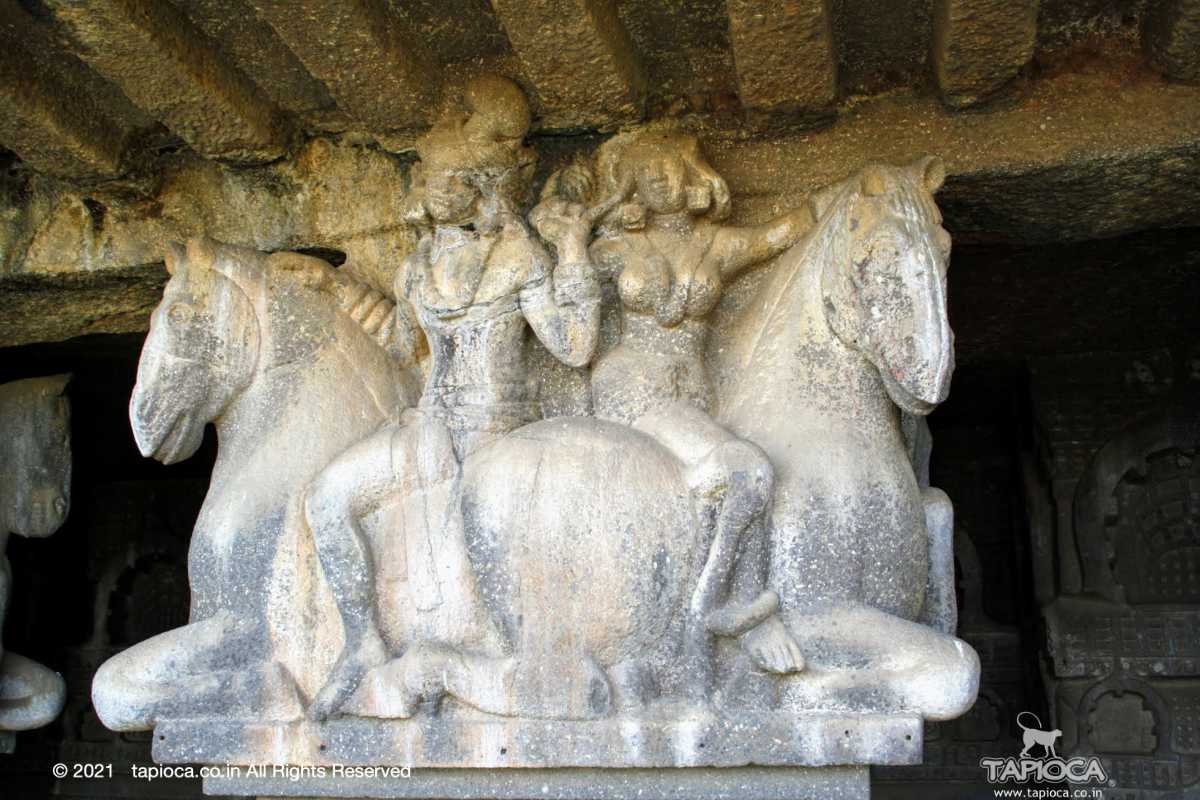 The facade on the slops of the hill.[/caption]
[caption id="attachment_2051" align="alignleft" width="1200"]
The facade on the slops of the hill.[/caption]
[caption id="attachment_2051" align="alignleft" width="1200"]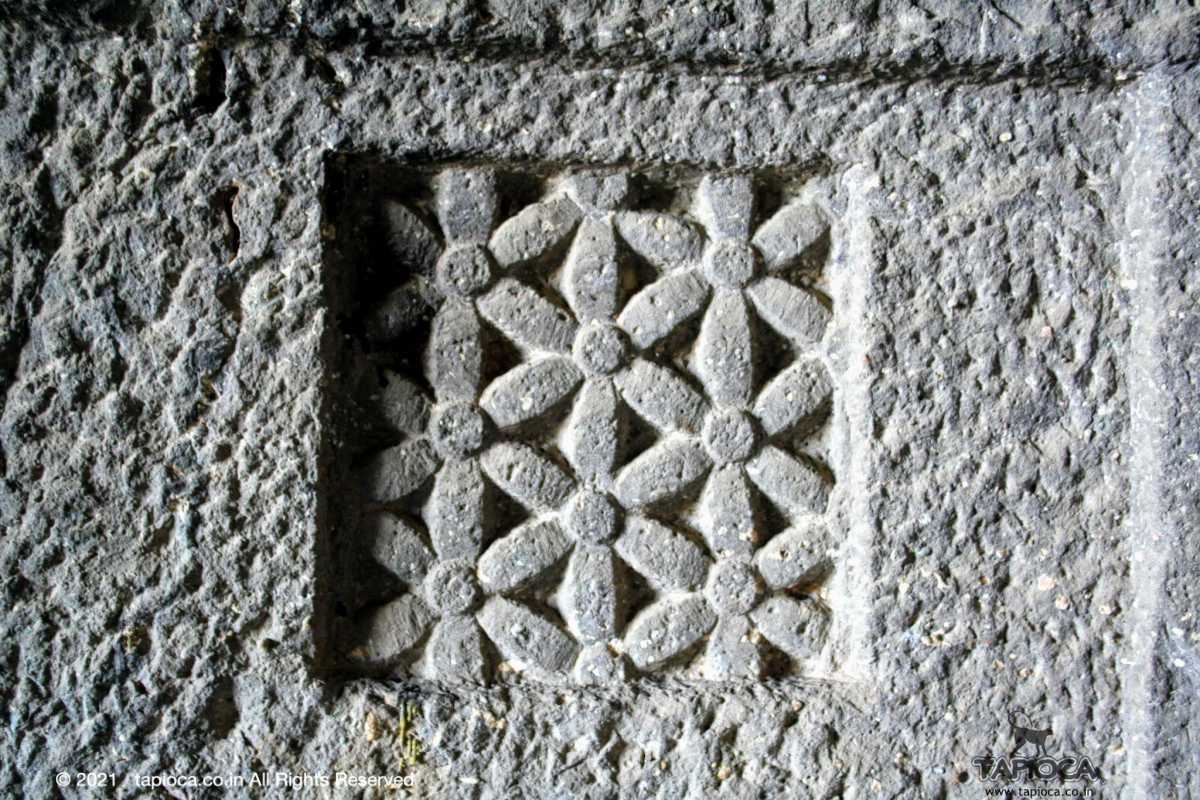 Bedsa [/caption]
[caption id="attachment_2047" align="alignleft" width="1200"]
Bedsa [/caption]
[caption id="attachment_2047" align="alignleft" width="1200"]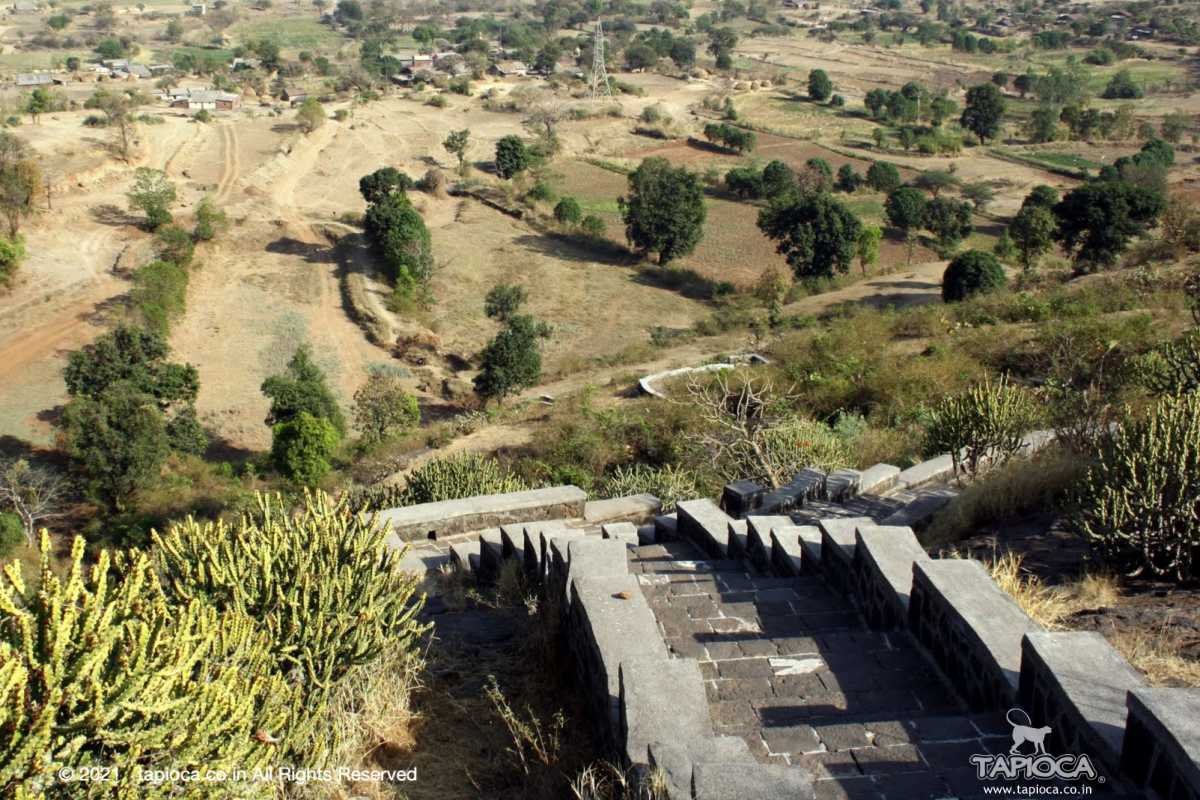 Bedse[/caption]
[caption id="attachment_2044" align="alignleft" width="1200"]
Bedse[/caption]
[caption id="attachment_2044" align="alignleft" width="1200"]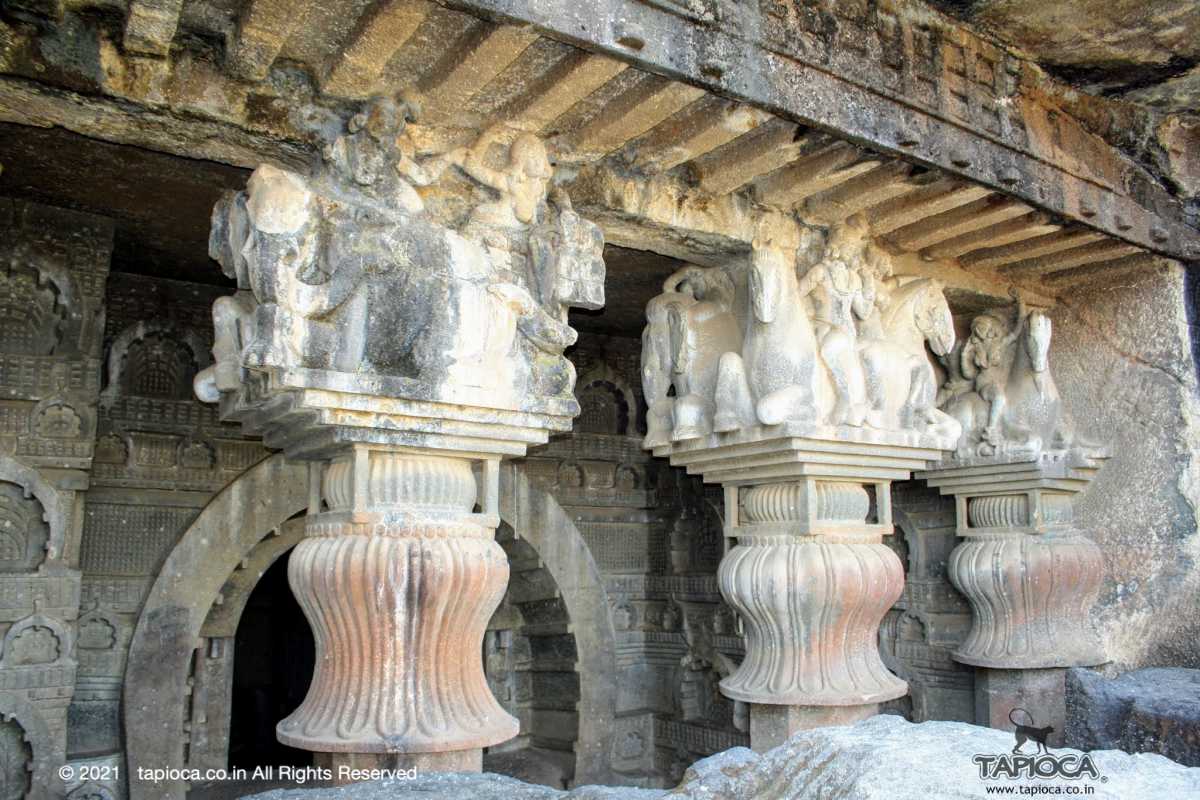 Bedse[/caption]
[caption id="attachment_2050" align="alignleft" width="1200"]
Bedse[/caption]
[caption id="attachment_2050" align="alignleft" width="1200"]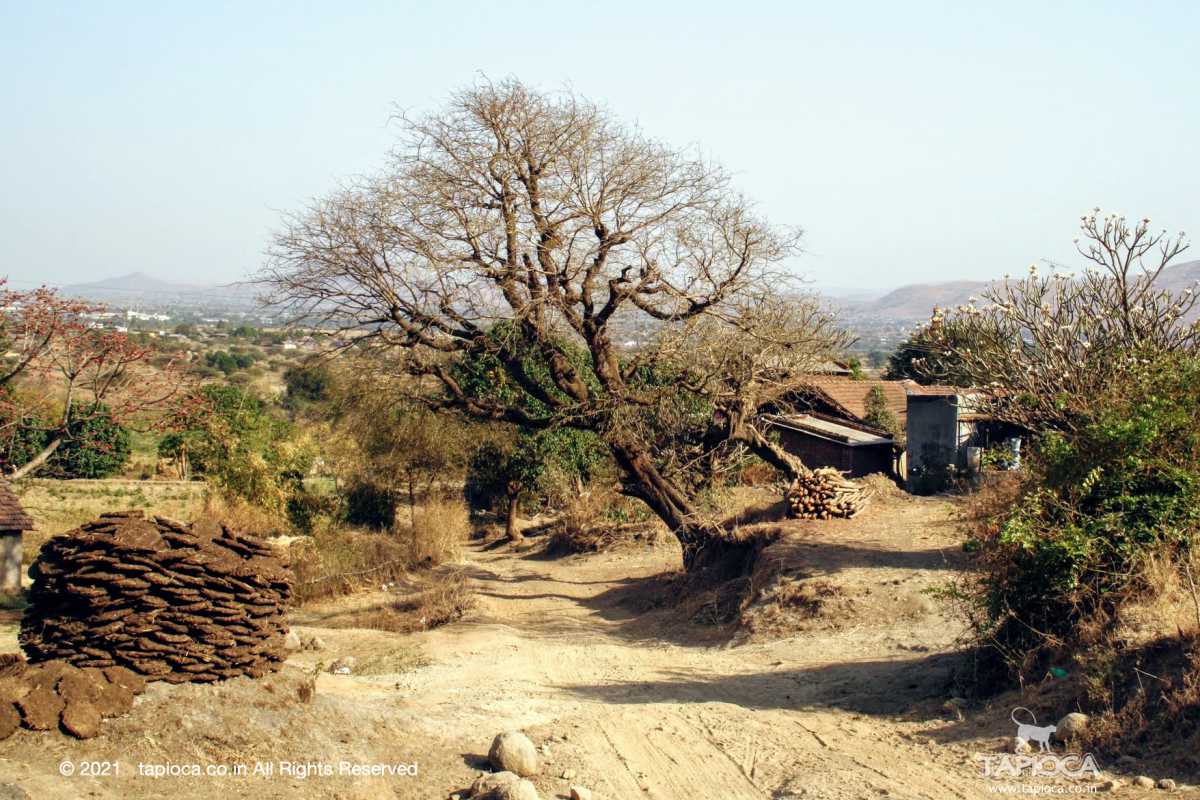 Bedse[/caption]">
Bedse[/caption]">
Though a well known Buddhist site , Bedse can easily be described as off the beaten path.
Set in the rugged back drop of Sahyadri ranges, Bedsa has one of the beautifully executed Chaitya in this region dating back to 2nd century BC.
Despite the relative difficulty to access this site, those who venture to the Bedsa caves are rewarded with splendid view of the valley from the courtyard of this majestic piece of rock cut architecture. The ambient is so calm and serene. Yes, in all probability you would not find another batch of visitors anywhere nearby.
Now what make Bedsa different?
Before, finding an answer to it let us see what rock cut architecture is. In conventional architecture structures are ‘assembled’ block by block using whatever building material. Whereas in case of rock cut architecture the construction is more of a scooping process than of a building process. In other words the unwanted material is excavated out of a giant rocky scrap using pickaxes and chisels. It resembles more like a sculpturing process. Thus every features of a building – right from doors to pillars to windows to the decorations on the walls - are created by removing the unwanted material around it.
[caption id="attachment_2088" align="alignleft" width="683"] The fluted façade of the Chaitya.[/caption]
The fluted façade of the Chaitya.[/caption]
The center piece of Bedsa’a attraction is the majestically executed Chaitya (Buddhist Shrine) , especially its porch and the façade. The hall is all tall as a typical two storied building. Baring its impressive size, the other decorations inside the Chaitya hall would not compete with the beauty of similar such Chaitya halls elsewhere, say Karla or Ellora.
But the story of the façade and the porch are different. Probably it is for the first time in such Buddhist architecture the concept of a horizontally split façade is used in the main entrance. Instead of a giant horse-shoe shaped main door, the faced has a door at the height of a single floor and a horse shoe shaped window over this door.
On either side of this entrance and window are multiple bands of horseshoe windows. They are not exactly windows, but the imitation of it in a thrilling order, one over the other. A fluted projection on either side adds to the elegance of the façade.
In front of the façade, supporting the roof of the porch stands four gigantic pillars. The most beautiful part of these pillars is the capitals. If you can climb on the rocky hill, you can reach somewhat at the eye level of theses capitals.
A word of caution as you climb over the rock. The surface could be slippery, especially during the rainy season. There are practically no barricades of balustrades to prevent a fall from the cliff edge. Be careful and never venture close to the unprotected edges of the rock. It is as if you are standing on the balcony on the second floor without a protective railing.
[caption id="attachment_2089" align="alignleft" width="683"] Pillar in the porch of the Chaitya with carved capitals[/caption]
Pillar in the porch of the Chaitya with carved capitals[/caption]
Beautifully dressed couples are portrayed as sitting on horses and elephants. The horses and elephants are in kneeling posture with their feet projecting out of the capital. That gives an impressing as if those are stand alone sculptures rather than part of the pillar.
Now the capital itself sits on an inverted lotus flower shape feature. This lotus feature resembles exactly as the one in the capital of the Ashoka pillar.
Unlike many other such grand scale Chaityas, the façade of the Bedsa Chaitya is partially hidden by the un- removed rock in front. It is as if the camouflage the Chaitya, there is only a narrow passage cut on the rock to access the porch.
[caption id="attachment_1389" align="alignleft" width="1024"] Fine example of the rock cut archetecture[/caption]
Fine example of the rock cut archetecture[/caption]
Inside of the Chaitya is typical. Rows of huge pillars stands on either sides of the Chaitya hall. At the centre of the semicircular end is the stupa with a protruding lotus bud image carved on the top.
The ceiling of the porch spots decorations that are smart imitation of such wooden structures.
[caption id="attachment_2090" align="alignleft" width="1024"] The Chaitya Hall of Bedsa Cave[/caption]
The Chaitya Hall of Bedsa Cave[/caption]
On the left of the Chaitya a distance around the hill is a Vihar or a Montessori. There is a huge centre hall with many rooms scooped on to its inner wall. All the rooms with identical façade face the center of the call. You can even spot the beds carved on the rock inside the rooms. The ceiling of the Montessori spots the rows of socket holes where once the wooden frame ribs were fixed.
Another special feature you can notice on either sides of the main Chaitya are the water tanks dug on the rock surface. From the courtyard of the caves you can spot on either sides of the Chaitya , some rectangular recesses as tall as a typical door. On the floor just inside this recess are the water tanks. Meshed woodedn frames are installed to protect people from falling trapped.
It was probably to collect rainwater. You can even see on the rock surface groves cut to channel the rainwater to the tanks.
On the right of the Chaitya facing the courtyard is a stupa. Beyond which you can see another cave with an unfinished stupa inside.
[caption id="attachment_1395" align="alignleft" width="1024"] The facade on the slops of the hill.[/caption]
The facade on the slops of the hill.[/caption]
[caption id="attachment_2051" align="alignleft" width="1200"] Bedsa [/caption]
Bedsa [/caption]
[caption id="attachment_2047" align="alignleft" width="1200"] Bedse[/caption]
Bedse[/caption]
[caption id="attachment_2044" align="alignleft" width="1200"] Bedse[/caption]
Bedse[/caption]
[caption id="attachment_2050" align="alignleft" width="1200"] Bedse[/caption]
Bedse[/caption]
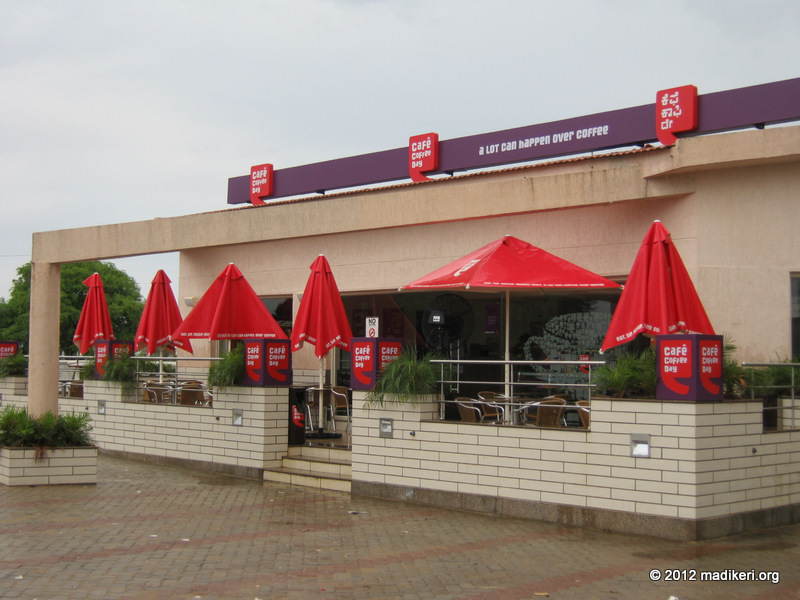
Cafe Coffee Day (CCD) outlet at Kampalapura
Cafe Coffee Day (CCD) outlet at Kampalapura near Periyapatna on the SH88
This is CCD outlet is about 13km after Hunsur (about 6km before Periyapatna).
You can also find another CCD outlet at Kushalnagar.
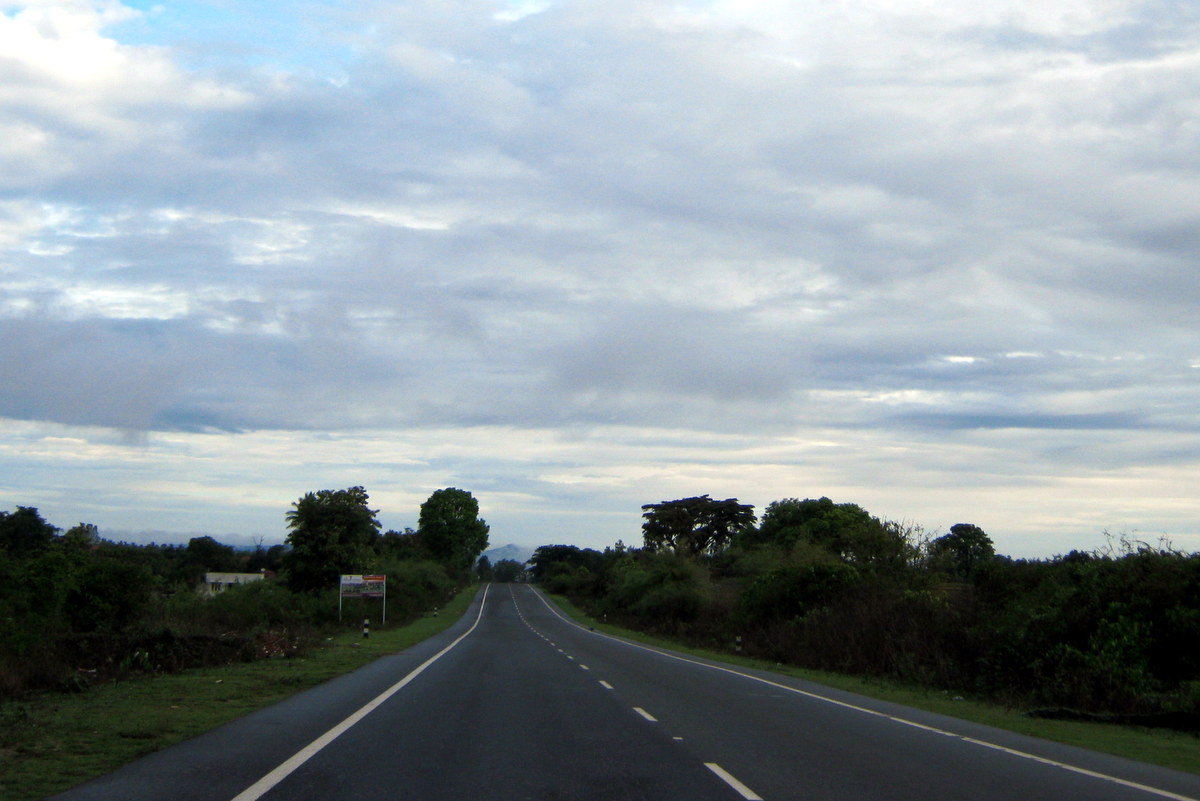
State Highway 88 ( SH 88 )
This highway takes you from Mysore to Madikeri. The road is in excellent condition.

